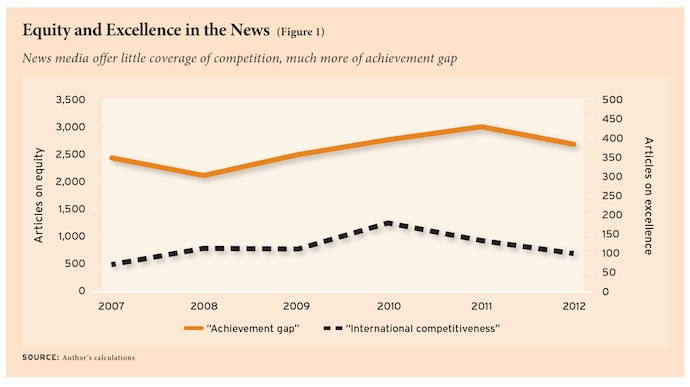An axiom of American education policy is that it waxes and wanes between equity and excellence. And these rhythms are attuned to the business cycle.
Take the Elementary and Secondary Education Act and Head Start, two fronts of President Lyndon Johnson’s War on Poverty. As Charles Murray explained in his seminal work, Losing Ground, poverty wasn’t anywhere to be seen on the policy agenda in 1960. And for good reason: after 15 years of a booming economy, in the wake of the Great Depression and then World War II, poverty had dropped dramatically. Living conditions were on the rise. Prosperity was widely shared.
What changed? The civil rights movement became ascendant and started to raise expectations, Michael Harrington published The Other America, and the issue was suddenly on everyone’s lips. As political scientist James Stimson would say, the public’s mood had shifted. Just a few years later, President Johnson envisioned the Great Society and implored his countrymen to help the “forgotten fifth.” The timing was no coincidence, argues Murray. The country was eager to do something about poverty because it could afford to do so.
And so Title I and Head Start were born, and with them a focus on narrowing the gaps in educational opportunity between black and white, rich and poor. Equity was dominant.
Fast-forward to 1983. After a decade of oil shocks and stagflation, and growing economic threats from Japan, the U.S. economy was in the midst of its worst recession in a generation. Social programs were under attack. And A Nation at Risk was born, with its warnings about a “rising tide of mediocrity.” With Ronald Reagan’s help, the pendulum had shifted to excellence.
That’s where it stayed for the next 15 years, giving birth to several iterations of the standards movement, efforts to raise graduation standards, and the beginnings of test-based accountability.
By the late 1990s, the economy was roaring again. To everyone’s surprise, the national debt evaporated. Wages rose, even for the poorest. Equity came back in style. Achievement gaps were rediscovered, and soon No Child Left Behind was born, along with an obsession on the performance of “subgroups.”
What about the last few years? According to this historical pattern, the recession of 2008–09 should have jolted our discussions away from equity and back to excellence. Did it? Without the perspective of time, it’s hard to know for sure. But I decided to go looking for some early indicators. Have we changed the way we talk (or write) about education? Are issues of equity less commonly raised now than before the economic downturn? Are issues of excellence once again on the rise?
To find out, I looked for a few key words in the country’s newspaper archives since 2007, using LexisNexis. Specifically, I searched for “achievement gap” as illustrative of equity concerns, and “international competitiveness” as indicative of excellence. (For the latter, I included a search for “internationally competitive,” too.)
Figure 1 shows what I found. My hypothesis did not exactly pan out. Though the focus on the “achievement gap” took a hit in 2008 as the economy started to fall apart, it quickly rebounded. Meanwhile, “competitiveness,” a relatively uncommon term, peaked in 2010, and then subsided.

By this measure, at least, the recent recession was a mere speed bump on the race toward equity.
Maybe we’ll see things differently a few years from now. If the Common Core standards live up to their promise of raising the rigor of America’s tests—and schools—we might see this as a time of resurgence for excellence. Doubly so if Secretary of Education Arne Duncan’s regulatory waivers of the No Child Left Behind Act take the pressure off schools for closing achievement gaps. Maybe the key factor is having a liberal Democrat in the White House—and maybe President Obama’s tenure will be seen as the last gasp for equity, the end of an era.
Maybe. For now, though, it appears that equity reigns supreme.
This article appeared in the Fall 2013 issue of Education Next. Suggested citation format:
Petrilli, M.J. (2013). Equity Trumps Excellence: Among news media, competition less important than achievement gap. Education Next, 13(4), 80-81.


